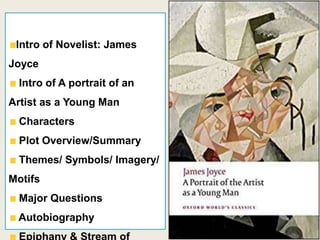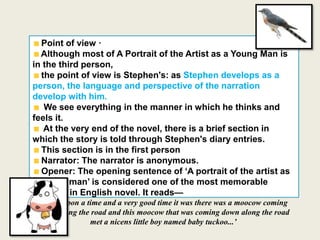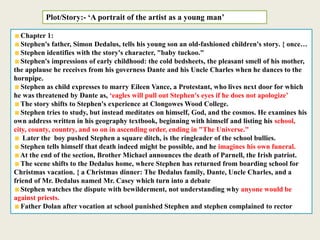Joyce portrait
- 1. Intro of Novelist: James Joyce Intro of A portrait of an Artist as a Young Man Characters Plot Overview/Summary Themes/ Symbols/ Imagery/ Motifs Major Questions Autobiography
- 2. James Joyce (2 February 1882 – 13 January 1941) is James Augustine Aloysius Joyce. 20th century Irish novelist and poet Pioneers of ‘stream of consciousness’ in novel and a new type of poetry called ‘Prose Poem’. He is one of the most influential writers in the modernist avant-garde of the early 20th century also. He used the style of ‘the examination of big events through small happenings in everyday lives’. Radically new or original Any creative group active in the innovation and application of new concepts and techniques in a given field (especially in the arts)
- 3. Ezra Pound, the noted American poet came to his help and got the book published by an American Publishing House The book was originally published as a newspaper serial and its title was ‘Stephen Dedalous’ after the name of its hero. At the advice of Ezra Pound, Joyce changed the title to ‘A Portrait of the artist as a young man’. It was not a commercial success. But it definitely created a permanent place for Joyce. Ezra Pound praised its style and voice.
- 4. Style of Narration The style of narration of the novel is called ‘Stream of consciousness technique’. Another stylistic technique for which Joyce is noted is the epiphany An epiphany reveals a moment in which a character makes a sudden, profound realization—whether prompted by an external object or a voice from within—that creates a change in his or her perception of the world. Joyce uses epiphany most notably in Dubliners, but A Portrait of the Artist as a Young Man is full of these sudden moments of spiritual revelation as well.
- 5. Icarus was the son of Daedalus, Athenian artisan. Both of them were imprisoned in the labyrinth. To come out Daedalus managed two big wings and attached them to their shoulders with wax. He taught the art of flying like birds to Icarus, but told him not to go closure to the Sun as the sunlight would melt the wax. Defying Daedalus’s warning, adventurous Icarus started flying and had gone very close to the Sun.
- 7. The novel is called a Künstlerroman meaning "artist's novel" in German. It is a narrative about an artist's growth to maturity. In general, this type of novels are called ‘fictional autobiography’ or a Bildungsroman More accurately it may be classified as a specific subgenre of Bildungsroman where a novel, tends to depict the conflicts of a sensitive youth against the values of a middle and upper class society of his or her time Joyce traces the religious and intellectual awakening of young
- 8. Point of view · Although most of A Portrait of the Artist as a Young Man is in the third person, the point of view is Stephen's: as Stephen develops as a person, the language and perspective of the narration develop with him. We see everything in the manner in which he thinks and feels it. At the very end of the novel, there is a brief section in which the story is told through Stephen's diary entries. This section is in the first person Narrator: The narrator is anonymous. Opener: The opening sentence of ‘A portrait of the artist as a young man’ is considered one of the most memorable openers in English novel. It reads— ‘Once upon a time and a very good time it was there was a moocow coming down along the road and this moocow that was coming down along the road met a nicens little boy named baby tuckoo...’
- 9. Plot/Story:- ‘A portrait of the artist as a young man’ Chapter 1: Stephen's father, Simon Dedalus, tells his young son an old-fashioned children's story. { once… Stephen identifies with the story's character, "baby tuckoo." Stephen's impressions of early childhood: the cold bedsheets, the pleasant smell of his mother, the applause he receives from his governess Dante and his Uncle Charles when he dances to the hornpipe. Stephen as child expresses to marry Eileen Vance, a Protestant, who lives next door for which he was threatened by Dante as, ‘eagles will pull out Stephen's eyes if he does not apologize’ The story shifts to Stephen's experience at Clongowes Wood College. Stephen tries to study, but instead meditates on himself, God, and the cosmos. He examines his own address written in his geography textbook, beginning with himself and listing his school, city, county, country, and so on in ascending order, ending in "The Universe." Later the boy pushed Stephen a square ditch, is the ringleader of the school bullies. Stephen tells himself that death indeed might be possible, and he imagines his own funeral. At the end of the section, Brother Michael announces the death of Parnell, the Irish patriot. The scene shifts to the Dedalus home, where Stephen has returned from boarding school for Christmas vacation. { a Christmas dinner: The Dedalus family, Dante, Uncle Charles, and a friend of Mr. Dedalus named Mr. Casey which turn into a debate Stephen watches the dispute with bewilderment, not understanding why anyone would be against priests. Father Dolan after vocation at school punished Stephen and stephen complained to rector
- 10. Plot/Story:- ‘A portrait of the artist as a young man’ Chapter 2: Stephen spent the summer in his family's new house in Blackrock, a town near Dublin. Stephen weekend walk with his father and uncle, listening to their political discussions and their stories about the past. Stephen did not understand many of their references. Stephen reads Alexandre Dumas's novel The Count of Monte Cristo, and is deeply engrossed in its adventure and romance. He imagines a future moment in which he will be transfigured by some magic revelation. At home, he wrote a love poem in his notebook, titling it "To E— C—" in imitation of Byron. As summer comes to an end, Stephen is told that he will be going to a new school because his father is no longer able to afford Clongowes. Stephen, now a teenager, is a student at Belvedere College, a Jesuit school. a discussion with his friend brought him back in memories where he announced Byron as the best poet but his friend oppressed. Remembering this quarrel, Stephen reflects on his father's command for him to be a good gentleman and a good Catholic, but the words sound hollow in Stephen's ears now. his father's sentimental tales of old friends and annoyed by his drinking. Visiting Mr. Dedalus's medical school, Stephen comes upon the startling word "Foetus" carved into the top of one of the desks in a lecture hall. Mr. Dedalus tells Stephen that he should always socialize with gentlemen. Stephen feels overwhelmed by a sense of shame and alienation, and regains his grip on himself by telling himself his own name and identity. Stephen feels distant from his father, and recalls a poem by Shelley about the moon wandering the sky in solitude.
- 11. Plot/Story:- ‘A portrait of the artist as a young man’ Chapter 2: Stephen and Mr. Deadalus enter the Bank of Ireland, leaving the rest of the family waiting outside, so that Stephen can cash the check for thirty-three pounds he has received as a literary prize. Stephen invites them to a fancy restaurant. This initiates a great spending spree in which Stephen regales his family members with costly gifts, treats, and loans. He had hoped that spending the money would bring the family together and appease some of their animosities, but he realizes it has not worked Stephen begins wandering the streets at night, tormented by sexual cravings. One night, a young prostitute dressed in pink accosts him. Stephen follows her to her room. He is reluctant to kiss her at first, but they eventually have sex. It is Stephen's first sexual experience.
- 12. Plot/Story:- ‘A portrait of the artist as a young man’ Chapter 3: In December, Stephen sits in his school classroom, daydreaming about the nice stew of mutton, potatoes, and carrots he hopes to have later. Stephen's thoughts soon turn to the wandering he will embark on at night and the variety of prostitutes who will proposition him. He realizes that from the sin of lust, other sins such as gluttony and greed have emerged. The school rector announces a retreat in honor of the celebration of St. Francis Xavier, whom he praises as a great soldier of God. Stephen feels his soul wither at these words. Stephen sits in the chapel as Father Arnall, appearing as a guest lecturer in Stephen's new school, reads a verse from the book of Ecclesiastes. Father Arnall urges the boys to put aside all worldly thoughts and win the blessing of the soul's salvation. The next day he falls even deeper into despair over the degraded state of his soul, suffering in agony and feeling a "deathchill." Crossing the square, Stephen hears the laugh of a young girl. He thinks of Emma, pained by the thought that his filthy sexual escapades with prostitutes have soiled Emma's innocence. Father Arnall describes the torments of hell in terrifying detail, beginning with the physical horrors. The sermon leaves Stephen paralyzed with fear, recognizing that hell is his destination. Together with Father Arnall, all the boys pray for God's forgiveness. The priest offers forgiveness and Stephen heads home feeling filled with grace. He goes to sleep. The next day he finds himself at the altar with his classmates and receives the Sacrament
- 13. Plot/Story:- ‘A portrait of the artist as a young man’ Chapter 4: The director asks Stephen whether he has ever felt he has a vocation, and urges him to consider a life in the church. When Stephen sees his disorderly house, he knows that his fate is to learn wisdom not in the refuge of the church, but "among the snares of the world. Arriving home, he asks his brothers and sisters where their parents are. Stephen impatiently waits for his father and tutor to return with news about the possibility of his admission into the university. He sets off walking toward the sea, encountering a group of teacher friars on the way Stephen comes upon several of his schoolmates who are swimming, and they jokingly greet him as they say his name in Greek. Reflecting on the myth of Daedalus that his name evokes, Stephen ponders his similarity to that "fabulous artificer" who constructed wings with which he flew out of imprisonment. Stephen is suddenly enraptured by this thought, and feels that he will soon begin building a new soul that will allow him to rise above current miseries. At that moment, he sees a beautiful girl wading in the water
- 14. Plot/Story:- ‘A portrait of the artist as a young man’ Chapter 5: Stephen eats a poor meal and examines the pawnshop tickets upon which his increasingly impoverished family survives. Mrs. Dedalus expresses her worry that Stephen's character has been changed by university life. From upstairs, Mr. Dedalus snaps that his son is a "lazy bitch." Annoyed and frustrated, Stephen leaves the house and wanders through the rainy Dublin landscape, quoting poems to himself and musing on the aesthetic theories of Aristotle and Aquinas. As he walks to the campus, The dean is trying to start a fire, and the two discuss the art of igniting flames. Stephen and the dean speak about aesthetics, but Stephen is disappointed by the older man's spotty knowledge, and the conversation is awkward. The next day, Stephen awakens in the morning in a mood of contentment and enchantment, having dreamed of erotic union with his beloved and composed a poem for Emma Sitting on the steps of the university library, Stephen watches a flock of birds circling above and tries to identify their species. His thoughts turn to lines from a Yeats play that has recently opened, lines that characterize swallows as symbols of freedom. At this point, the narrative switches to a journal form, composed of dated entries written by Stephen himself, from a first-person perspective. Stephen speaks of a squabble with a fellow student and of attempting to read three reviews in the library. He records two dreams: one of viewing a long gallery filled with images of fabulous kings, and another of meeting strange mute creatures with phosphorescent faces. He mentions meeting his father, who asks him why he does not join a rowing club. In his entry dated April 15, Stephen records meeting "her"—meaning Emma—on Grafton Street.
- 15. Plot/Story:- ‘A portrait of the artist as a young man’ Chapter 5: The following day, he has a vision of disembodied arms and voices that seem to call to him, urging him to join them. Stephen ends his journal with a prayer to his old father, Daedalus, whom he calls "old artificer," to stand him in good stead.
- 16. Themes/ Symbols/ Imagery/ Motifs Modernism With the publication of A Portrait of the Artist as a Young Man, James Joyce became recognized as one of the most important modernists shaping the future of literature. Modernism is a style of writing that writers and other artists used with trends such as symbolism, expressionism, imagism, and surrealism. Modernist writers rejected 19th century realism, and remained disengaged from mainstream thought and values, and to present their readers with complex new forms. Point of View Portrait is written in third-person omniscient. Although Joyce is telling us Stephen’s story, we often feel “inside Stephen’s head.” For the most part, we see only what Stephen sees and we know only what he knows. We are just far enough outside of Stephen that we are free to pass judgment on him and wonder what he will do next.
- 17. Themes/ Symbols/ Imagery/ Motifs When reading Portrait you are taken into the conscious and unconscious thoughts that run endlessly through a character’s mind, and these may include memories of the past suddenly interrupted by fantasies about the future fused with some elements of the present. Stream of Consciousness: the intermingled flow of a character’s thoughts, feelings and perceptions. In Portrait the stream of consciousness was presented through interior monologue: Stephen’s inner thoughts to the reader with no interpretation by the narrator. Epiphany: This term originated in the Christian religion to define a moment when God is clearly revealed. Joyce used it to denote secular revelation in day-to-day life. There are many epiphanies in Portrait, sudden revelations which change Stephen’s life. Motif: an idea, image, or element which is found in many literary works. Leitmotif: is a motif which occurs repeatedly within a single work. Joyce uses a number of recurring motifs in connection with various situations. Pay attention to the following motifs and leitmotifs as you read: eyes and the fear of blindness; water (in all its forms); roses; cows; the colors white, red, yellow and green; birds; flight; cold and warmth. In Portrait Joyce’s style changes with Stephen’s age. When your reading you will recognize Stephen’s progression of age through his Joyce’s sentence structure and Stephen’s thoughts.
- 18. Themes/ Symbols/ Imagery/ Motifs Symbolism: Women Stephen is resistant towards kissing the prostitute because deep down, he knows that his actions are sinful and will lead to punishments. For a period of time, Stephen tried to stay away from women because he does not want to fall into temptation once again. Emma is different from the other women that Stephen interacts with. She helps Stephen get a touch of pure love teaches him how to appreciate beauty and female purity. Colors The colors Green and Maroon show up a lot throughout the novel. The color Green represents his Irish heritage and the Irish Nationalist Movement. Stephen believes that these two colors together represent conflict. Stephen wonders "which was right, to be for the green or for the maroon.“ Flight and Wings The association of flight with Stephen’s experience stems from his affiliation with Daedalus who was known for creating wings of feather and wax. Stephen envisions his soul flying on metaphorical wings of his own construction; like Daedalus, he must fly to escape what he perceives to be his prison (Ireland), and the "nets" it casts to entrap him (religion, language, nationality).
- 19. Themes/ Symbols/ Imagery/ Motifs Symbolism: Music From the very first page, music is constantly in the background. Stephen is a singer; we don’t know how talented he is (he is asked to perform several times, which indicates that he must be pretty good), but it’s never a central part of his identity, as far as we’re concerned. He often thinks of language in terms of its musicality and rhythmic nature. He refers to phrases making up "chords" with words, an idea that combines the concept of musical harmony with poetic beauty. Example, when he is about to leave the Director’s office in Chapter Four (on the brink of deciding whether or not to join the Jesuits), the priest’s "mirthless" response to a sudden burst of music from the street shocks Stephen, making him realize that he could never become a priest himself.


















